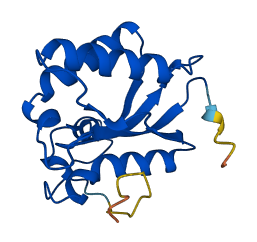Q47152
Gene name |
rayT (TnpAREP, yafM, b0228, JW0218) |
Protein name |
REP-associated tyrosine transposase |
Names |
|
Species |
Escherichia coli (strain K12) |
KEGG Pathway |
ecj:JW0218, eco:b0228, |
EC number |
|
Protein Class |
REP-ASSOCIATED TYROSINE TRANSPOSASE (PTHR36966) |

Descriptions
TnpAREP is a transposase. TnpAREP binds repetitive extragenic palindromic sequences (REP) and cleaves bacterial interspersed mosaic elements (BIMEs) both upstream and downstream of the REP sequence.
TnpAREP is in an autoinhibited state in the crystal, as it appears to be physically blocking access of a ssDNA cleavage substrate to the active site.
This autoinhibition is likely evolved to prevent REPs from sweeping through genomes.
Autoinhibitory domains (AIDs)
Target domain |
9-119 (Transposase domain) |
Relief mechanism |
Ligand binding |
Assay |
Structural analysis |
Accessory elements
No accessory elements
References
Autoinhibited structure

Activated structure
2 structures for Q47152
| Entry ID | Method | Resolution | Chain | Position | Source |
|---|---|---|---|---|---|
| 4ER8 | X-ray | 260 A | A | 1-165 | PDB |
| AF-Q47152-F1 | Predicted | AlphaFoldDB |
No variants for Q47152
| Variant ID(s) | Position | Change | Description | Diseaes Association | Provenance |
|---|---|---|---|---|---|
| No variants for Q47152 | |||||
No associated diseases with Q47152
No regional properties for Q47152
| Type | Name | Position | InterPro Accession |
|---|---|---|---|
| No domain, repeats, and functional sites for Q47152 | |||
Functions
| Description | ||
|---|---|---|
| EC Number | ||
| Subcellular Localization |
|
|
| PANTHER Family | PTHR36966 | REP-ASSOCIATED TYROSINE TRANSPOSASE |
| PANTHER Subfamily | PTHR36966:SF1 | REP-ASSOCIATED TYROSINE TRANSPOSASE |
| PANTHER Protein Class | viral or transposable element protein | |
| PANTHER Pathway Category | No pathway information available | |
No GO annotations of cellular component
| Name | Definition |
|---|---|
| No GO annotations for cellular component |
7 GO annotations of molecular function
| Name | Definition |
|---|---|
| bubble DNA binding | Binding to DNA segment that contains a bubble. A bubble occurs when DNA contains a region of unpaired, single-stranded DNA flanked on both sides by regions of paired, double-stranded DNA. |
| DNA binding | Any molecular function by which a gene product interacts selectively and non-covalently with DNA (deoxyribonucleic acid). |
| DNA hairpin binding | Binding to a DNA region containing a hairpin. A hairpin structure forms when a DNA strand folds back on itself and intrachain base pairing occurs between inverted repeat sequences. |
| sequence-specific DNA binding | Binding to DNA of a specific nucleotide composition, e.g. GC-rich DNA binding, or with a specific sequence motif or type of DNA e.g. promotor binding or rDNA binding. |
| single-stranded DNA binding | Binding to single-stranded DNA. |
| single-stranded DNA endodeoxyribonuclease activity | Catalysis of the hydrolysis of ester linkages within a single-stranded deoxyribonucleic acid molecule by creating internal breaks. |
| transposase activity | Catalysis of the transposition of transposable elements or transposons. Transposases are involved in recombination required for transposition and are site-specific for the transposon/transposable element. |
2 GO annotations of biological process
| Name | Definition |
|---|---|
| DNA recombination | Any process in which a new genotype is formed by reassortment of genes resulting in gene combinations different from those that were present in the parents. In eukaryotes genetic recombination can occur by chromosome assortment, intrachromosomal recombination, or nonreciprocal interchromosomal recombination. Interchromosomal recombination occurs by crossing over. In bacteria it may occur by genetic transformation, conjugation, transduction, or F-duction. |
| DNA transposition | A type of transposition in which a transposable element (transposon) is moved to another part of a genome, either by a cut-and-paste mechanism or a replicative mechanism. |
No homologous proteins in AiPD
| UniProt AC | Gene Name | Protein Name | Species | Evidence Code |
|---|---|---|---|---|
| No homologous proteins | ||||
| 10 | 20 | 30 | 40 | 50 | 60 |
| MSEYRRYYIK | GGTWFFTVNL | RNRRSQLLTT | QYQMLRHAII | KVKRDRPFEI | NAWVVLPEHM |
| 70 | 80 | 90 | 100 | 110 | 120 |
| HCIWTLPEGD | DDFSSRWREI | KKQFTHACGL | KNIWQPRFWE | HAIRNTKDYR | HHVDYIYINP |
| 130 | 140 | 150 | 160 | ||
| VKHGWVKQVS | DWPFSTFHRD | VARGLYPIDW | AGDVTDFSAG | ERIIS |